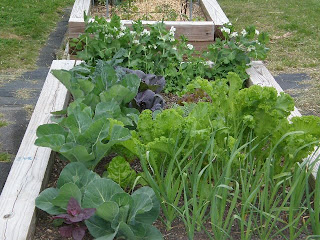




With the weather finally warming a bit, I have transplanted tomatoes into the garden and have planted squash, cucumbers, beet, carrots, and bean seeds (along with some basil and cayenne pepper seed to see if I can get some plants from direct seeding this year). Here you see a seedling squash, which is just emerging in one of my ornamental beds. That is the only place I had room for vining crops this summer.
The beautiful purple flower stalks are the first of the baptisia this year, and the red salvia is flowering for the first time in my garden. Both my small and my large varieties of Indian Hawthorne are in full flower as of Saturday (white on the small and pink on the large), and they look and smell amazing. I am sorry there isn't enough room for photos of them as well; maybe later this week.
I had to include a photo of the vegetable bed that holds all of the greens, the sugar snap peas, the cauliflower, bok choy, mustard, and now new tiny seedling beets and carrots. I gave all my vegetables and my strawberries a dose of fertilizer last week, and the effect really shows. If your plants seem to be just sitting still in the garden and not growing, consider whether some Nitrogen is in order.
Finally look at this beautiful Russian kale. These plants were from last fall, and I have been harvesting on and off all winter. Despite their large size, the leaves are very tender, and I chopped the stems along with the greens for a wonderful pan of sauteed greens that made a great base for some salmon and a drizzle of basalmic vinegar.
The bees are working all the flowers, but so far they are not putting away any honey. I hope this year to get a great honey crop, rather than just producing lots of swarms.















